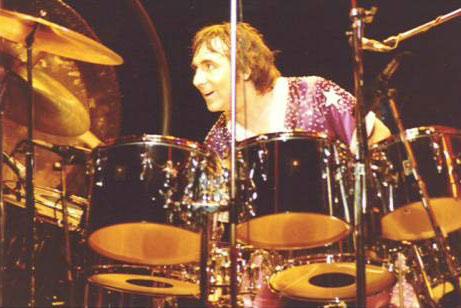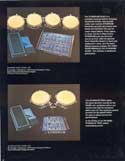Keith Moon’s Drumkits: 1977–1978 – final Premier kits
1977–1978 – final Premier kit
Keith’s final stage kit, used for his last two appearances: filming for The Kids Are Alright. Bluish chrome Premier kit, similar to the previous White/Cream Premier kit.

Ca. 1978, Shepperton.

Timeline
- First use:
- 15 Dec. 1977 – Gaumont State Theatre, Kilburn, London, UK (for The Kids Are Alright film).
- Last use:
- 25 May 1978 – Shepperton Studios, Middlesex, UK (for The Kids Are Alright film).
Specification
Note: Diagram is missing second timpani; and includes incorrect crash above high toms (B), and timbales (2).
Drums:
Premier Custom Built (birch), finished in chromed steel cladding.
- 22″ bass drum
- 16″ single-headed (concert) tom
- 15″ single-headed (concert) tom
- 18″ floor tom
- 16″ floor tom
- 14″ single-headed (concert) tom
- 13″ single-headed (concert) tom
- 12″ single-headed (concert) tom
- 10″ single-headed (concert) tom
- 14″ × 10″ mounted tom
- 14″ × 10″ mounted tom
- 14″ × 10″ mounted tom
- 14″ × 6½″ or 5½″ snare
Finish:
The chromed steel cladding was a wrap of chrome-plated steel added to the birch shell. It added 10% to the retail purchase price of the drum, and a fair amount to the weight. (Andy Valentine: Incidentally, it’s said that Premier lost money on every chromed shell they sold — the difference was more than 10 per-cent.)
Cymbals:
Likely Paiste 2002 series
- 22″ ride (Zildjian)
- 20″ crash
- 14″ splash (Zildjian)
- 18″ crash
- 14″ hi-hat
- gong
Stands:
Premier Lock Fast
Bass Pedals:
Premier 250 pedal
Drumskins
Remo black dot drumheads on toms
Whereabouts
Unknown.
Selected quotes
All quotes and references are copyright their original owners and are included for reference only.
International Musician and Recording World, October 1978
KM: I’ve got 16 drums in my kit and on every song I use a different set of four or five so eventually I’ve used all 16 drums. Sometimes I use the timpani, sometimes the timbale, sometimes I do runs that’ll go right around eight drums and sometimes I’ll just use bass drum, snare drum and hi-hat. I’ve got everything I need there. I can cover from a roar with the timpani right up to the smallest timbale which is about 6″. That’s why I have so many drums onstage because, with The Who, there’s Pete who plays a lot of chords and John who plays very intricate bass figures that I work with and we have this empathy between us. Sometimes I’ll build up with timpani, sometimes I’ll build up on cymbal or with a roll around the kit.
Everything is tightened down and nailed and strengthened with extra screws drilled in. Everything is double braced so I can get up, as we do at the end of the act, and actually stand on the kit without breaking the fittings or ripping them away from the wood. Inside each drum I have a metal plate to support them so I can actually stand on top of the kit. The whole thing is solid as a rock.
I have my own P.A. system virtually so I have to check the sound that comes out of the drum P.A. In fact, we have to use special mikes for the drums because the amount of air, from hitting it so hard, would produce this “popping” sound … like someone blowing into a mike. So they put windshields on and that helps the tonal reproduction.
Photo Gallery

1978

1977

1977

July 1977, Shepperton Studios.
Premier Natural single-bass drum kit
Used in the studio in 1978, as seen in Ramport studio “Who Are You” footage in The Kids Are Alright.

Ca. 1978, studio kit diagram, by Martin Forsbom.
Specification
Drums:
Premier Custom Built in natural finish (varnished birch shells)
- 1: bass drum
- 2: snare
- 3–10: single-headed toms
- 11–13: double-headed toms
- 14–15: floor toms
- 16–17: single-headed toms
Finish:
Andy Valentine:
The double-headed shells (kick and toms) were Premier’s top-of-the-range Resonators. These drums are readily identified by a second birch “shell” or inner liner, bent with the grain, that was sprung into place inside the main shell — all the internal hardware, bolt-heads, etc., and therefore hidden.
Premier themselves recommended that, if cutting a hole in the “display” or resonant heads (for miking purposes), a minimum amount of head be left or else the resonator shell had no effect. All the resonant heads seem to be missing entirely here.
Stands
This kit was the first and only time that the standard Premier “oval post” tom mounting block was used on one of Keith’s bass drums. These were prone to cracking after a few years’ gentle use.
Cymbals:
Likely Paiste 2002 series
- Crash
- Crash
- China (effect cymbal)
- Ride (Zildjian)
- hi-hat
Whereabouts
- Three toms from this kit are on display in the Hard Rock Café in Boston, Massachusetts, USA.
- A portion of this kit is available for sale at Rock Stars Guitars:
- Bass drum, floor tom, 2 x mounted toms, hi-hat stand, kick pedal, snare stand. Original batter heads. Paiste “Sound Edge” Hi Hats, 2 x Paiste cymbals.

May 1978, in the studio, with natural-finish single-bass drum kit, with extra hi-hat.

May 1978, in the studio, with natural-finish single-bass drum kit, with extra hi-hat and Zildjian cymbal visible in foreground.

Three toms from Keith’s 1978 kit on display at the Hard Rock Café in Boston, Massachusetts.

Keith’s 1978 Premier Natural kit, courtesy Rock Stars Guitars. (Cymbal stands and seat are from Premier cream/white kit.)
Additional notes
Syndrums
In 1978, Moon had started using Syndrums, a synthesized computer drumpad.
Staccato
Moon was about to sign with Staccato before he died. Staccato is known for the “weird” shape of their drums.
- Pictures available at endino.com/photo14.html.
- New Staccato website at: staccato-art.co.uk. The website indicates:
[Keith Moon] used them on one (or possibly the last film of the Who playing together) Channel 4, late ’70s.
The following info has not been confirmed:
Pat Townshend, the inventor and designer of Staccato drums:
“I was round at Nicko McBrain’s flat in Kilburn at the time and he was with me throughout my meetings with Keith. We both had the pleasure of standing 20′ in front of the Staccato kit when Keith was being recorded for the program, Keith was going crazy with a big grin on his face.”
The program was recorded in Teddington.
The following is from an eBay auction for a Staccato drumkit:
Staccato kit, consisting of 8″,10″,12″, 16″ toms (black over white) and 22″ bass drum (white over black).
This was the first and only black/white Staccato Drum set made at the first Factory at Chippenham Mews, Notting-Hill Gate, London in 1977/78.
The 22″ white-over-black bass drum is the very first Staccato Bass Drum ever made.
This setup was first loaned to Keith Moon in 1978 for his evaluation. He was so excited about Staccato’s that a partnership deal was agreed only days before his untimely death.
Resources and Information
Contributors:
Many thanks to the following, who have made this page possible:
- Martin Forsbom (forsbom@gmail.com)
- Brad Rodgers at whocollection.com.
- Huw Owens (huw.owens@ntlworld.com)
- Andy Valentine
- Nicholas Yamamoto
Additional information:
- Brad Rodgers at whocollection.com.
- David Brewis at Rock Stars Guitars, for pictures of Moon’s drumsticks, timbales, claves and drumheads.
- Tam Rankin at vintprem.moonfruit.com for information on vintage Premier drums.
Bibliography:
- Drums & Drumming magazine, October/November 1989.
- Modern Drummer, September 2003.
- Moon, the Life and Death of a Rock Legend, by Tony Fletcher. 1999.
Manufacturers’ sites
- Premier Drums: premier-percussion.com
- Ludwig Drums: ludwig-drums.com
- Paiste Cymbals: paiste.com
- Zildjian Cymbals: zildjian.com
- Slingerland Drums: slingerland.com (now owned by Gibson)
- Vistalites Drums: vistalites.com
- Zickos Drums: zickosdrums.com




